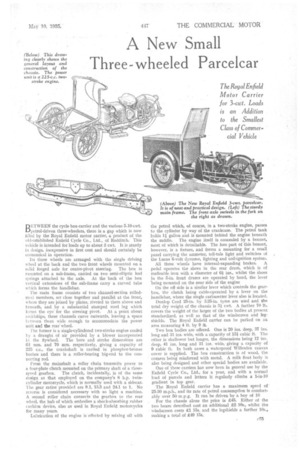A New Small Three-wheeled Parcelcar
Page 113

If you've noticed an error in this article please click here to report it so we can fix it.
BETWEEN the cycle box-carrier and the various 5-10-cwt. petrol-driven three-wheelers, there is a gap which is now filled by the Royal Enfield motor carrier, a product of the old-established Enfield Cycle Co., Ltd., of Redclitch. This vehicle is intended for loads up to about 3 cwt. It is sturdy in design, inexpensive in first cost and should certainly be economical in operation.
Its three wheels arc arranged with the single driving wheel at the back and the two front wheels mounted on a solid forged axle for centre-pivot steering. The box is mounted on a sub-frame, carried on two semi-elliptic leaf springs attached to the axle. At the back of the box vertical extensions of the sub-frame carry a curved tube which forms the handlebar.
The main frame consists of two channel-section rolledsteel members, set close together and parallel at the front, where they are joined by plates, riveted to them above and beneath, and by a substantial stamped steel lug which forms the eye' for the steering pivot. At a point about amidships, these channels curve outwards, leaving a space between them wide enough to accommodate the power unit and the rear' wheel.
The former is a single-cylindered two-stroke engine cooled hy a draught of air provided by a blower incorporated in the flywheel. The bore and stroke dimensions are 64 mm. and 70 mm. respectively, giving a capacity of 225 c.c., the crankshaft is carried in phosphor-bronze bushes and there is a roller-bearing big-end to the connecting rod.
From the mainshaft a roller chain transmits power to a four-plate clutch mounted on the primary shaft of a threespeed gearbox. The clutch, incidentally, is of the same design as that employed on the company's 8 h.p. twincylinder motorcycle, which is normally used with a sidecar. 'I he gear ratios provided are 9.1, 13.3 and 24.1 to 1. No reverse is considered necessary with so light a machine. A second roller chain connects the gearbox to the rear wheel, the hub of which embodies a shock-absorbing rubber cushion device, also as used in Royal Enfield motorcycles for many years.
Lubrication of the engine is effected by mixing oil with
the petrol which, of course, in a two-stroke engine, passes to the cylinder by way of the crankcase. The petrol tank holds 11 gallon and is mounted behind the engine beneath the saddle. The engine itself is concealed by a bonnet, most of which is detachable. The fore part of this bonnet, however, is a fixture, and forms a mounting for a small panel carrying the ammeter, tell-tale light and switches of , the Lucas 6-volt dynamo, lighting and coil-ignition system.
Ali three wheels have internal-expanding brakes. A pedal operates the shoes in the rear drum, which is of malleable iron with a diameter of 6 ins., whilst the Shoes in the 5-in, front drums are operated by hand, the lever 'being mounted on the near side of the engine On the off side is a similar lever which controls the gearbox, the clutch being cable-operated by a lever on the handlebar, where the single carburetter lever also is located.
Dunlop Cord '25-in. by 3.25-in. tyres are used and the total dry weight of the chassis is 3i cwt. A further 70 lb. covers the weight of the larger of the two bodies at present standardized, as well as that of the windscreen and legshields. The Royal Enfield carrier can be parked on an area measuring 4 ft. by 9 ft.
Two box bodies are offered. One is 20 ins, deep, 37 ins. long and 31 ins, wide, with a capacity of 13i cubic ft. The other is shallower but longer, the dimensions being 12 ins. deep, 41 ins, long and 31 ins, wide, giving a capacity of 9 cubic ft. In both cases a waterproof Willesden canvas cover is supplied. The box construction is of wood, the corners being reinforced with metal. A milk float body is also being designed and other special bodies are available.
One of these carriers has now been in general use by the Enfield Cycle Co., Ltd., for a year, and with a normal load of parcels and letters it regularly climbs a 1-in-10 gradient in top gear.
The Royal Enfield carrier has a maximum speed of 25-30 m.p.h., and its rate of petrol consumption is comfortably over 50 m.p.g. It can be driven by a boy of 16
For the chassis alone the price is £45. Either of the two boxes described cost an additional £2 10s., whilst the windscreen costs 7£1 15s. and the legshields a further 10s., making a total of £49 15s.




































































































































































